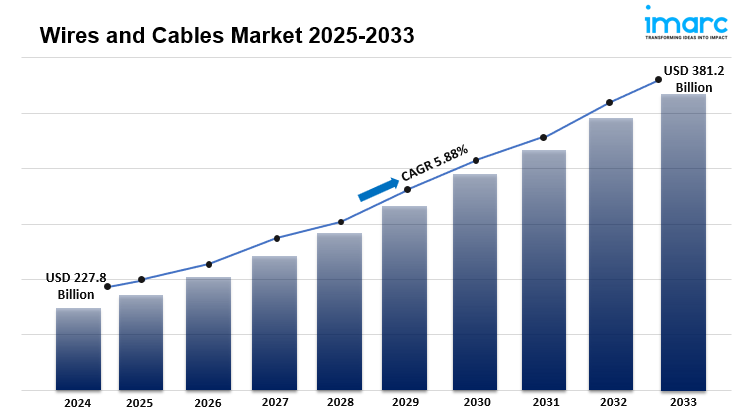Market Overview:
The global wires and cables market has witnessed significant growth, reaching a value of USD 214.7 billion in 2023 and is projected to expand to USD 366.7 billion by 2032, growing at a robust CAGR of 6.13% during 2024-2032. This growth is driven by increasing urbanization, rising demand for electricity, and advancements in infrastructure development. Additionally, the adoption of renewable energy systems and smart grid technologies is further fueling market expansion
Study Assumption Years:
- Base Year: 2023
- Historical Year: 2017-2022
- Forecast Year: 2024-2032
Wires and Cables Market Key Takeaways:
- The market size was valued at US$ 214.7 billion in 2023 and is expected to reach US$ 366.7 billion by 2032, growing at a CAGR of 6.13% during the forecast period .
- Asia-Pacific dominates the market, driven by rapid industrialization, urbanization, and government investments in infrastructure projects.
- The renewable energy sector is a key driver, with increasing demand for specialized cables in wind and solar power installations.
- Technological advancements, such as high-performance fiber optic cables, are reshaping the industry landscape.
- The market is segmented by voltage (low, medium, high), installation (overhead, underground), and end-use industries (energy, telecom, construction, etc.).
- Rising adoption of smart grids and IoT-enabled systems is boosting demand for advanced cables.
- North America and Europe are also witnessing steady growth due to modernization of aging power infrastructure.
Market Growth Factors:
Infrastructure Development and Urbanization
The rapid pace of urbanization and infrastructure development, particularly in emerging economies, is a major growth driver for the wires and cables market. Governments worldwide are investing heavily in smart cities, transportation networks, and energy infrastructure, which require extensive cabling solutions. For instance, the expansion of metro rail systems and high-speed rail projects in Asia-Pacific has significantly increased the demand for medium and high-voltage cables. Additionally, the construction of residential and commercial buildings further fuels the need for low-voltage cables, ensuring steady market growth.
Renewable Energy and Sustainability Initiatives
The global shift towards renewable energy sources, such as wind and solar power, has created a surge in demand for specialized cables. These cables are essential for transmitting power from renewable energy plants to the grid. Governments and private players are increasingly investing in renewable energy projects to meet sustainability goals, further driving market growth. For example, offshore wind farms require advanced submarine cables for power transmission, which has become a lucrative segment within the industry. This trend is expected to continue as countries aim to reduce carbon emissions.
Technological Advancements and Smart Grid Adoption
Technological innovations in the wires and cables industry, such as the development of fiber optic cables and IoT-enabled systems, are transforming the market. Smart grids, which rely on advanced cabling solutions for efficient energy distribution and monitoring, are gaining traction globally. These grids enable real-time data collection and energy management, enhancing overall efficiency. Additionally, the rise of 5G networks and increasing internet penetration are driving the demand for high-performance cables in the telecommunications sector. Such advancements are expected to propel the market forward in the coming years.
Request Sample For PDF Report: https://www.imarcgroup.com/wires-cables-market/requestsample
Market Segmentation:
Breakup by Voltage:
- Low Voltage: Used in residential and commercial buildings for power distribution.
- Medium Voltage: Essential for industrial applications and urban infrastructure projects.
- High Voltage: Primarily used in power transmission and renewable energy projects.
Breakup by Installation:
- Overhead: Commonly used in rural and suburban areas for power distribution.
- Underground: Preferred in urban areas for aesthetic and safety reasons.
Breakup by End-Use Industry:
- Energy and Power: Includes applications in power generation, transmission, and distribution.
- Telecommunication: High demand for fiber optic cables in 5G and broadband networks.
- Construction: Used in residential, commercial, and industrial buildings.
- Automotive: Essential for electric vehicles and charging infrastructure.
- Others: Includes applications in aerospace, defense, and healthcare.
Market Breakup by Region:
- North America (United States, Canada)
- Asia Pacific (China, Japan, India, South Korea, Australia, Indonesia, Others)
- Europe (Germany, France, United Kingdom, Italy, Spain, Russia, Others)
- Latin America (Brazil, Mexico, Others)
- Middle East and Africa
The wires and cables market has seen significant advancements, including the development of high-performance fiber optic cables for 5G networks and IoT applications. Additionally, the adoption of renewable energy systems has led to increased demand for submarine and specialized cables. Key players are focusing on R&D to enhance product efficiency and sustainability, aligning with global energy transition goals. These innovations are reshaping the market landscape.
Key Players:
- Prysmian Group
- Nexans
- Southwire Company
- Sumitomo Electric Industries
- LS Cable & System
- Furukawa Electric
- General Cable
Note: If you need specific information that is not currently within the scope of the report, we will provide it to you as a part of the customization.
About Us:
IMARC Group is a global management consulting firm that helps the world’s most ambitious changemakers to create a lasting impact. The company provide a comprehensive suite of market entry and expansion services. IMARC offerings include thorough market assessment, feasibility studies, company incorporation assistance, factory setup support, regulatory approvals and licensing navigation, branding, marketing and sales strategies, competitive landscape and benchmarking analyses, pricing and cost research, and procurement research.
